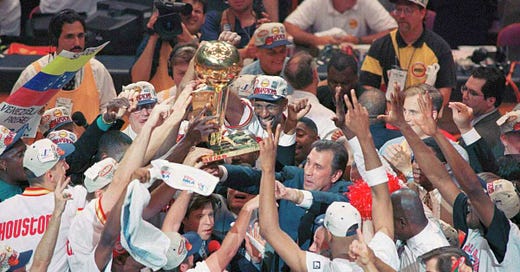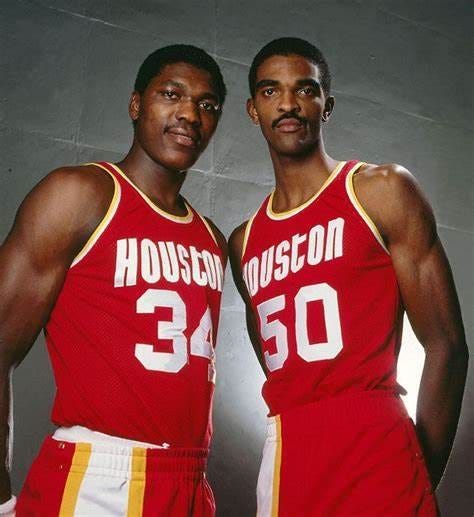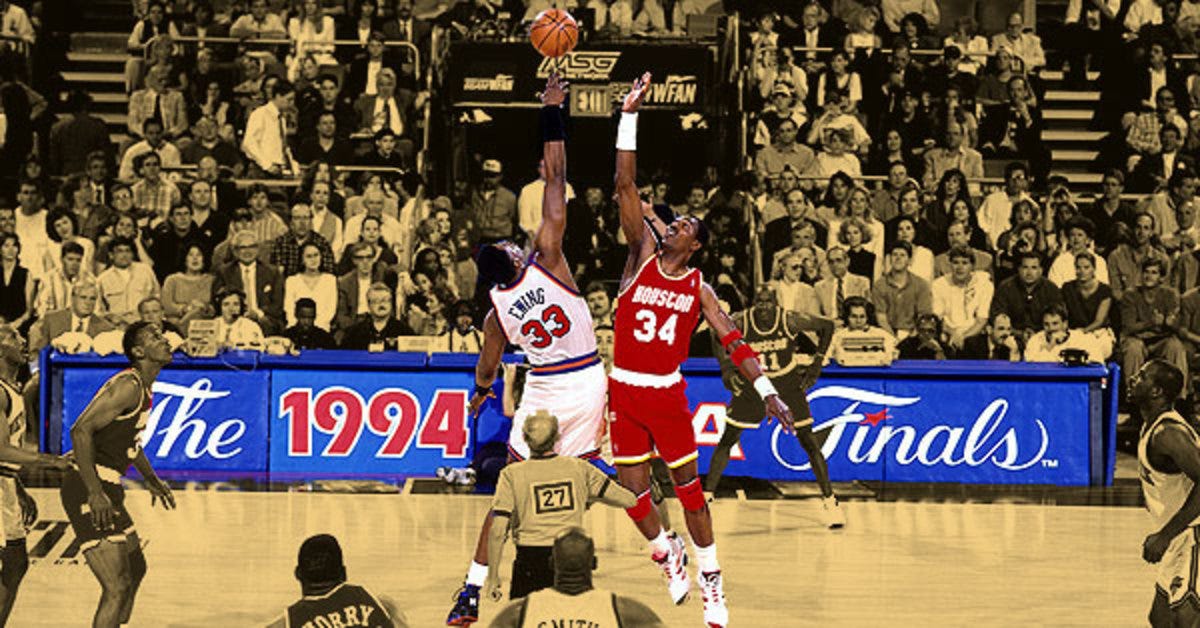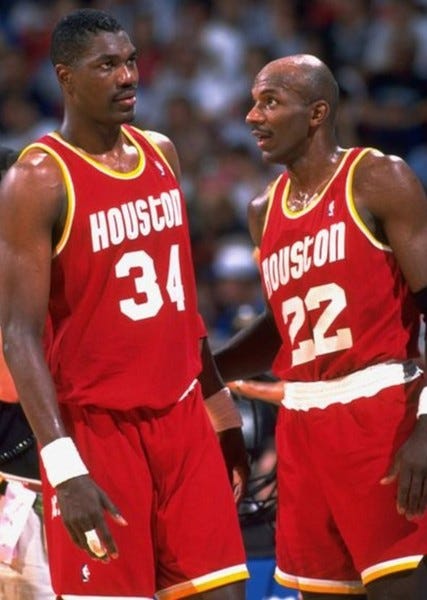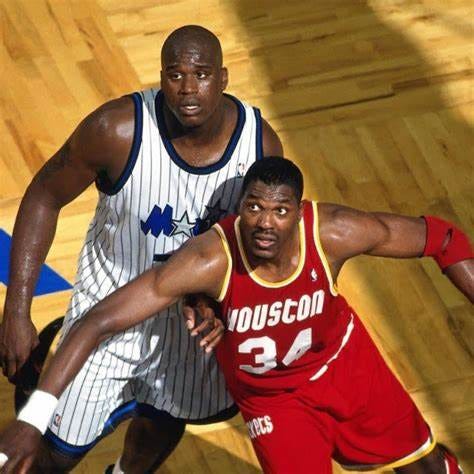The Heart of a Champion: The Story of the 94-95 Houston Rockets
With Head Coach Rudy Tomjanovich at the helm, Hakeem Olajuwon & the Houston Rockets climbed the mountaintop twice & revolutionized basketball in the process.
The Houston Rockets should not have won the NBA Championship in 1994, and they definitely should not have been able to repeat the following year. Center Hakeem Olajuwon, the all-time leader in blocked shots, was their only star player. During their two-year run, the Rockets took on teams with more star power who on paper should have beaten them in the playoffs. The Rockets’ success caused the basketball world to collectively scratch their heads and wonder how they managed to pull off the impossible not once, but twice. It ultimately came down to the same things that builds the foundation for any championship, a coach with a plan who has faith in his players to execute it and in turn those players gain faith in their coach.
Power forward Rudy Tomjanovich was a five-time All-Star for the Houston Rockets during his eleven-year career from 1970-81 and he is the fourth all-time leading scorer in franchise history. Tomjanovich along with teammates Calvin Murphy and Moses Malone helped establish Houston as a serious basketball town even though the Rockets came up short in the playoffs throughout the 1970s. Following his retirement, the Houston Rockets hired Tomjanovich to work as a scout and two years later he was promoted to assistant coach. Even as the franchise cycled through head coaches, Tomjanovich was kept on the coaching staff as his work ethic could not be easily replaced. He loved working with players one on one and spent hours studying game footage. The Hamtramck, Michigan native’s hard work was about to pay off, for the Houston Rockets were about to be gifted with not just one, but two franchise saviors.
The Houston Rockets continued to struggle to advance in the playoffs after Tomjanovich’s retirement and the bottom fell out when Moses Malone was traded to the Philadelphia 76ers before the 1982-83 season. The Rockets’ 14-68 record was the worst in the league, and they were awarded the first pick in the NBA draft which they used to select 7’4 center Ralph Sampson. The Rockets were still the worst team in the league despite Sampson winning the Rookie of the Year Award during the 1983-84 season and they were bestowed the first overall pick in the draft yet again. The 1984 Draft would be the most important draft in the league’s history. Magic Johnson and Larry Bird’s rivalry saved the NBA from insolvency and television ratings and attendance figures were rising. The 1984 Draft featured future superstars Michael Jordan, Hakeem Olajuwon, Charles Barkley, and John Stockton who would make the NBA a global phenomenon in the 1990s.
The Rockets picked Hakeem Olajuwon, whom Houston basketball fans were already familiar with. Olajuwon was the center for the University of Houston Cougars whom from 1981 to 1984 dominated college basketball. Dubbed “Phi Slama Jama”, Olajuwon and teammate Clyde Drexler led the Cougars to two consecutive NCAA Championship games where they were defeated by North Carolina State and later by Georgetown University which was led by center Patrick Ewing.
After Hakeem Olajuwon was drafted, The Houston Rockets moved Ralph Sampson to the power forward position to create one of the most unique front courts in NBA history. Dubbed “The Twin Towers” by fans and the media, the powerful duo propelled the Rockets to a 48-34 record in the 1984-85 season, but they were eliminated by the Utah Jazz in the first round of the playoffs. The Rockets improved to a 51-31 record in the 1985-86 season, and they pulled off the unthinkable in the Western Conference Finals by defeating the reigning champion Los Angeles Lakers in just five games. Hakeem Olajuwon did not overpower defenders like a prototypical center. Instead, he used his footwork, which he had honed while playing soccer in Nigeria to out finesse his rivals. Olajuwon’s post moves and pump fakes were dubbed “The Dream Shake” and the Lakers couldn’t stop it. Lakers head coach Pat Riley said of Olajuwon after the series was over “We tried everything. We put four bodies on him. We helped from different angles. He's just a great player.”
Although The Houston Rockets were defeated by the Boston Celtics in the NBA Finals, the franchise and Houston fans had every reason to be optimistic about the future. Hakeem Olajuwon and Ralph Sampson were two of the best big men in the league and they had only played together for two seasons. It was only a matter of time before the Rockets dethroned the Lakers as the top team in the Western Conference and delivered Houston its first NBA Championship. It wasn’t to be. The road to a championship would be a hard one.
On February 4, 1987, Ralph Sampson tore cartilage in his left knee during a game against the Denver Nuggets. Not wanting to let his team down, Sampson hurried through his rehab so he would be available in the playoffs. The Rockets were eliminated by the Seattle Supersonics in the conference semifinals and Ralph Sampson was never the same again. After injuring his knee again early in the 1987-88 season, head coach Bill Fitch soured on Sampson, and he was traded to the Golden State Warriors. Sampson would battle injuries for the rest of his career as his playing time dwindled. He played his final NBA game in 1992.
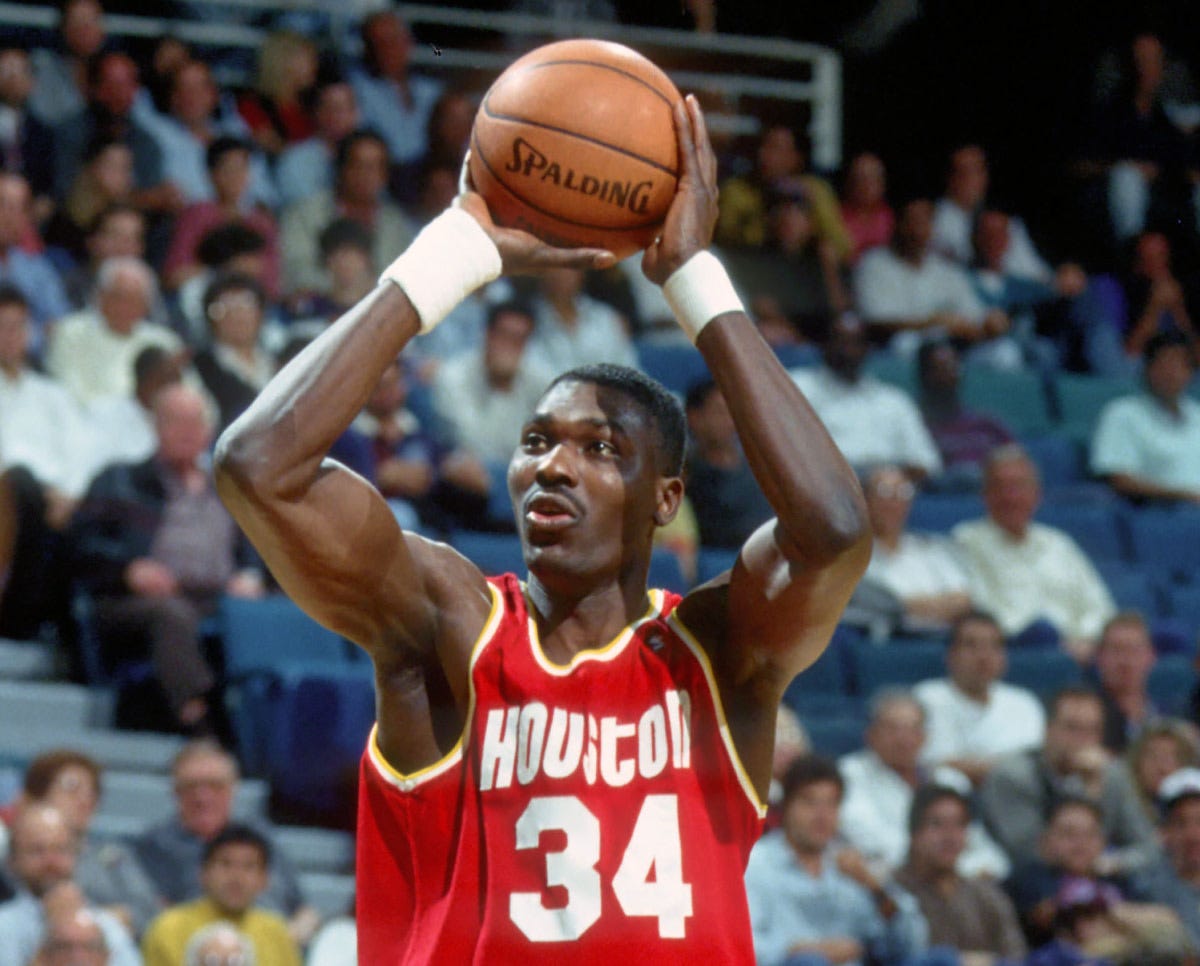
The loss of Ralph Sampson put the Houston Rockets in basketball purgatory. Over the next five seasons, the Rockets made the playoffs but were eliminated in the first round. They were good, but not good enough. Head coach Don Chaney was fired after the Rockets started the 1991-92 season with a 26-26 record and Rudy Tomjanovich was appointed interim head coach. The Rockets improved under Tomjanovich, enough for him to be named permanent head coach, but the team still missed the playoffs for the first time in Hakeem Olajuwon’s career.
Relations between the Rockets and Olajuwon reached an all-time low during this period. Olajuwon was not highly paid in comparison to other top centers. He was making $3 million a year while Partick Ewing of the New York Knicks was being paid $9 million a year. The contract Olajuwon signed had a clause which barred any renegotiation, but that didn’t stop him from trying. The Rockets balked at his demand for a $15 million contract for the 1994-95 season. Olajuwon also felt Rockets’ owner Charlie Thomas was more concerned with lining his pockets instead of spending money to surround him with quality players and he had no problem telling the press this. In March 1992, Olajuwon refused to play a game due to hamstring tightness. The Rockets suspended him in response and General Manager Steve Patterson publicly accused Olajuwon of faking the injury as a ploy to force a renegotiation of his contract. Unsurprisingly, Olajuwon was outraged by the accusations saying “I would never use the excuse of an injury to negotiate a contract. I use my skills.” After Olajuwon told reporters Thomas was “a coward”, it seemed all but certain that he would be traded.
On November 2, 1992, The Houston Rockets departed the United States for the NBA season opener in Tokyo, Japan. Hakeem Olajuwon and Charlie Thomas sat next to each other on the flight. Free of any intermediaries and media scrutiny, they settled their problems like men. In March 1993, Olajuwon signed a four-year $30 million contract extension.
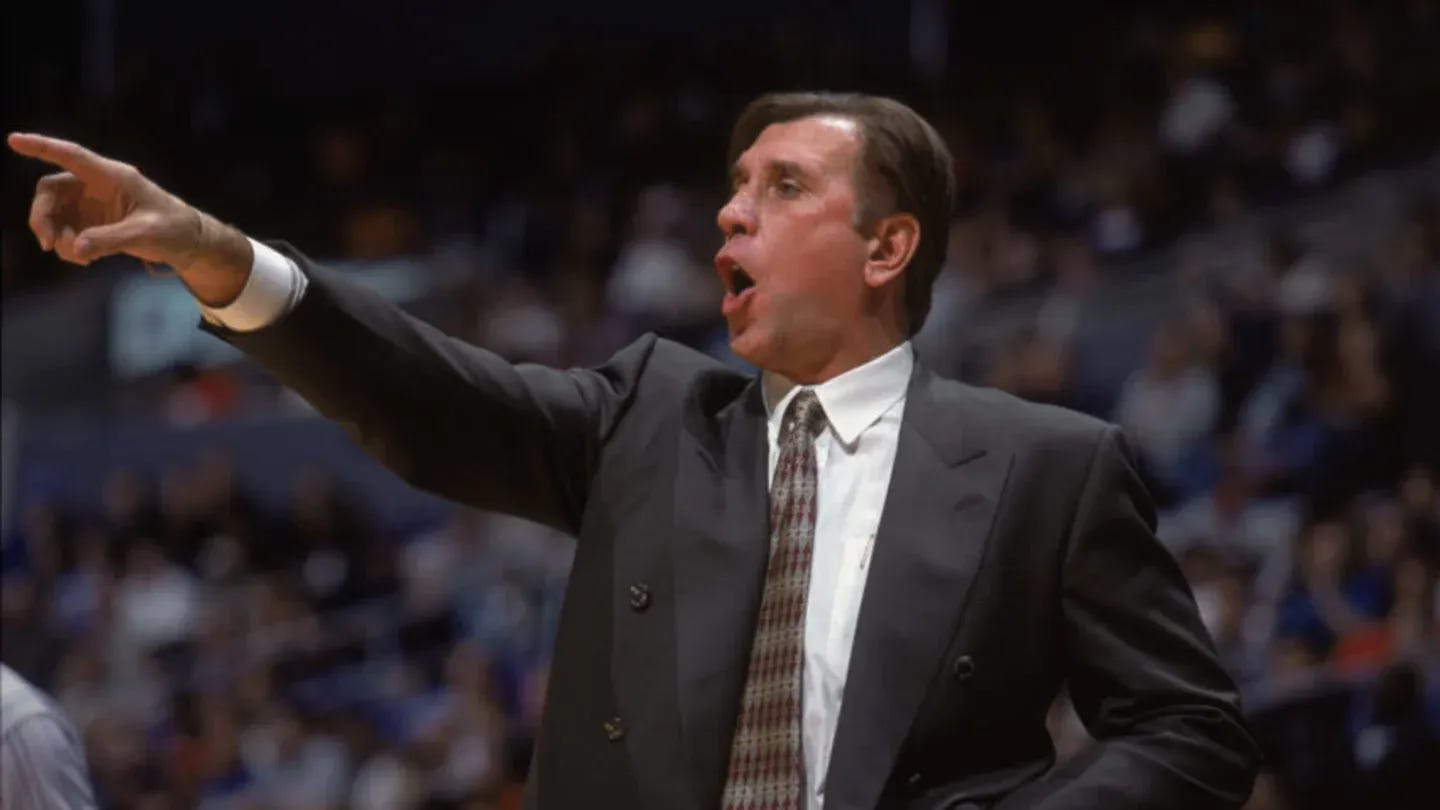
Rudy Tomjanovich had long felt that the Houston Rockets and even Hakeem Olajuwon had not reached their full potential and came up with an offensive system to help them realize it. Being a former player and a long-time assistant, Tomjanovich knew exactly what kind of conditions players thrived under. Players needed a system to give them guidance on the court, but the system also needed to allow them the freedom to improvise.
Under Tomjanovich’s system, Hakeem Olajuwon would continue to be the Rockets’ defensive anchor and the offense’s tip of the spear. What would change was how the rest of the Rockets were utilized on the court. Tomjanovich’s system placed shooters like Kenny Smith, Vernon Maxwell, and Robert Horry around Olajuwon to create mismatches for the defense. If the opposing team doubled Olajuwon, he would pass it to one of the shooters on the perimeter for a three pointer or long two-point shot. This forced opposing teams to guard every Rocket on the court and treat them as a scoring threat. However, Olajuwon was impossible to guard one on one so if teams stopped doubling him, it made scoring for him all the more easier.
Most importantly, Tomjanovich’s coaching style was not authoritarian, and he wasn’t emotionally distant. He took on the role of an encourager and made sure his players knew that he had the utmost faith in their abilities. In turn, the Houston Rockets not only believed in Tomjanovich but also believed in one another. Tomjanovich expanded on his philosophy after his retirement from coaching saying “Encouragement builds confidence. Over the years, I tried to verbalize what my philosophy was becoming. I would say it's 80% positive, 20% correction. When we're doing a tape and the coach gets excited — 'Look at this, this is what I'm talking about' — they get an idea of what I think good Rockets basketball is.”
The Houston Rockets executed Tomjanovich’s strategy flawlessly and they finished in second place in the Western Conference with a 55-27 record. Hakeem Olajuwon was named to the All-Star Game, won the Defensive Player of the Year award, and was named to the All-NBA and All Defensive first teams. However, the Seattle Supersonics beat the Rockets in seven games in the Western Conference Semi-Finals. Despite the loss, the Houston Rockets knew they had taken a critical step forward and with Michael Jordan announcing his retirement at the end of the season all of a sudden the path to a championship was wide open.
The 1993-94 season started off with a bang. The Houston Rockets won their first fifteen games and were 14-0 during November. The Rockets finished the season with the best defensive rating in the NBA. Hakeem Olajuwon averaged 27.3 points, 11.9 rebounds, 3.6 assists, 1.6 steals and 3.7 blocks per game. He became the second player in NBA history to be named both the Defensive Player of the Year and the MVP in the same season. The first player to accomplish this feat was Michael Jordan.
When the three-point line was brought over from the defunct American Basketball Association to the NBA in 1979 it was regarded as a gimmick by purists. It took several years for players to grow comfortable with it and even then, three pointers were only taken to either tie or win the game. Rudy Tomjanovich’s offensive strategy was the first time a coach ever truly integrated the three-point line into their system. In the 1993-94 season, teams were taking 9.9 three-point shots a game. However, the Houston Rockets took 15.7 threes a game which led the league.
The Rockets finished the season with a 58-24 record and easily dispatched the Portland Trailblazers in the first round. However, they lost the first two games of the semi-finals to the Phoenix Suns after blowing double digit leads in both games. The Rockets rallied and took control of the series to beat the Suns in seven games. They then beat the Utah Jazz four games to one in the Western Conference Finals. For the first time in eight years, the Rockets were going to the NBA Finals where they would be facing the New York Knicks.
The 1994 NBA Finals was a rematch a decade in the making. In 1984, Hakeem Olajuwon’s Houston Cougars were defeated by Patrick Ewing’s Georgetown Hoyas in the NCAA Championship Finals. Now the two centers were meeting again in what was to be a slog of a series. Under head coach Pat Riley, New York Knicks established themselves as the best defensive team in the Eastern Conference with an ugly but effective strategy. They wore opposing teams down with their physicality and bruising style of play with what was called the “No Layups Defense”. Now they were facing an equally great defensive team in the Houston Rockets. The defense oriented 1994 Finals was not exactly fun to watch for casual fans. Neither team scored more than 93 points in a game. The series was ultimately decided by Hakeem Olajuwon’s battle with Patrick Ewing in the post. Ewing was outplayed at every turn. He scored only 18.9 points a game while Olajuwon dominated with 26.9 points. After seven brutal low scoring games, the Houston Rockets came away with their first championship in franchise history and Hakeem Olajuwon won the Finals MVP award.
The Houston Rockets got off to another strong start at the beginning of the 1994-95 season, but they soon found themselves struggling in the face of better competition in the Western Conference, particularly from the San Antonio Spurs. By the All-Star break, the Rockets only had a 29-17 record which was mediocre for a defending champion.
An ugly incident on February 6, 1995, during a game against the Portland Trail Blazers forced the Rockets management to make drastic changes to salvage their season and changed the trajectory of both franchises. The incident took place at the Veterans Memorial Coliseum in Portland where guard Vernon Maxwell charged into the stands and attacked one of the fans. Maxwell claimed the fan hurled racial slurs and him and made fun of his recently stillborn daughter, which the fan denied. Of course, Maxwell wouldn’t have attacked this man for no reason. The NBA suspended Maxwell for ten games which was the second longest suspension in NBA history and was fined a record $20,000.
On Valentine’s Day 1995, the Rockets traded power forward Otis Thorpe to the Portland Trail Blazers in exchange for shooting guard Clyde Drexler and small forward Tracy Murray who excelled at three-point shooting. Drexler and Hakeem Olajuwon were teammates at the University of Houston and Rockets were hoping to recapture the magic of Phi Slama Jama. However, the Phi Slama Jama era ended the decade before and while Drexler was still effective, he wasn’t quite the superstar he was in the late 1980s and early 90s. The trade certainly reeked of desperation to fans and the media.
Pairing old teammates together in an attempt to recapture their glory years rarely works no matter what the sport is. The Los Angeles Kings of the National Hockey League reunited Wayne Gretzky with his former Edmonton Oilers teammate Jari Kurri, the greatest goal scoring tandem in hockey history, in the hopes they would lead them to a Stanley Cup. However, they ultimately fell short in the 1993 Finals. In the NBA, the Dallas Mavericks reunited Jason Kidd and Vince Carter, who led the New Jersey Nets to back-to-back Finals appearances in 2002 and 2003, to help them defend their 2011 Championship. However, both players were washed up and could not assist Dirk Nowitzki in bringing another title to Dallas. A more recent example of superstar reunions gone wrong are the many franchises who have paired James Harden with his old Oklahoma City Thunder teammates over the last several seasons. The Houston Rockets reunited Harden with Russell Westbrook in 2020, the Brooklyn Nets reunited Harden with Kevin Durant in 2021, and the Los Angeles Clippers reunited James Harden and Russell Westbrook again in 2023. Each reunion ended with every team failing to meet expectations.
The Clyde Drexler trade did not improve the Houston Rockets win loss record. Hakeem Olajuwon missed eight games after the All-Star break after being diagnosed with anemia and hyperthyroidism. Meanwhile, Vernon Maxwell was outraged that Drexler had taken his spot in the starting lineup, so he quit the team and sat out the rest of the season, a decision he came to regret. The Rockets were 18-18 in the second half and limped into the playoffs with a sixth-place finish in the Western Conference with a 47-35 overall record.
Nothing special was expected of the Houston Rockets and they were expected to revert to their old ways of being first round fodder. However, something crucial happened throughout this stretch which went unnoticed at the time. Olajuwon’s absence gave Clyde Drexler the opportunity to fully integrate himself within the Rockets’ system. The Houston Rockets also shot more threes than they did the season before. The rest of the teams in the NBA averaged 15.3 points a game while the Rockets shot 21.4 threes per game, once again leading the league. The Rockets also had something else. Something you can’t analyze with statistics. They had faith in one another and even a rocky season couldn’t shake it.
The Houston Rockets’ 1995 playoff run was one of the most remarkable in NBA history. They’re the classic example of why one can’t count any team out in the postseason because in the postseason anything can happen. They faced the Utah Jazz again and were able to defeat them in five games despite falling behind 2-1. The Rockets finished in sixth place while the Jazz finished third. In the semi-finals, The Rockets faced off against the Phoenix Suns and clawed back from a 3-1 deficit to win the series in seven games. Then they faced their greatest challenge yet, the San Antonio Spurs who were led by superstar center David Robinson.
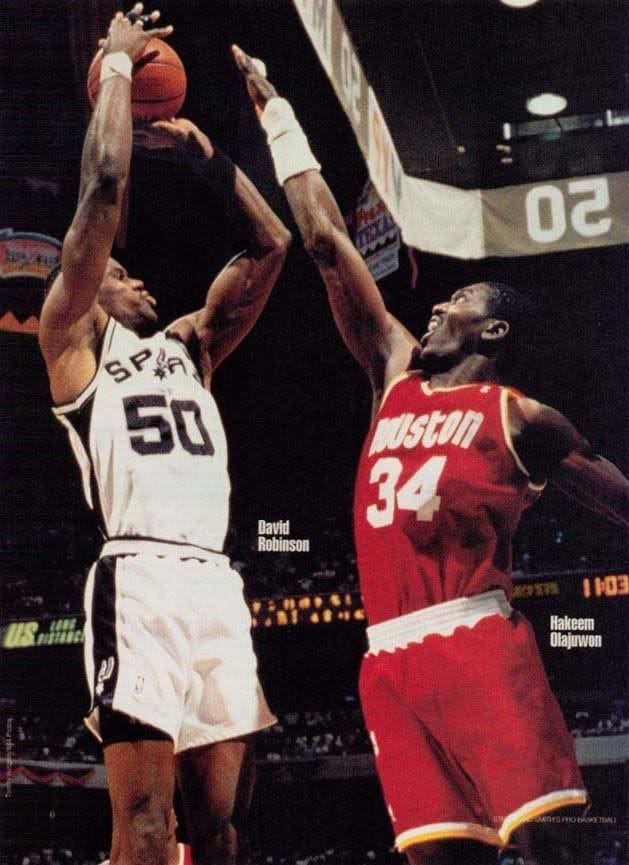
What puts Hakeem Olajuwon in the upper echelon of NBA centers transcends mere statistics. What makes an all-time great center is a willingness to take over the game and dominate. They refuse to let their teams lose crucial games. It requires physical and mental toughness. Bill Russell had this quality, and he led the Boston Celtics to eleven championships in thirteen seasons. Kareem Abdul Jabbar was held in such high regard by his teammates they nicknamed him “Captain” for his leadership and clutch play. Bill Walton was a one-man defense for the UCLA Bruins and the Portland Trail Blazers when he led them to their respective championships, and he would have won more if not for his numerous feet injuries. Moses Malone, who mentored Olajuwon when he was at the University of Houston, dominated the boards and delivered the final championship in Philadelphia 76ers history. When Shaquille O’Neal dedicated himself there was nobody on the court who could stop him, and he won three Finals MVPs in a row from 2000-02 while he was with the Los Angeles Lakers. Tim Duncan led the San Antonio Spurs to the playoff every year of his 19-year career and won five championships. More recent examples of centers who can singlehandedly win games are Giannis Antetokounmpo and Nikola Jokic. In the 1995 Western Conference Finals, Hakeem Olajuwon was going to prove that he ranked with basketball’s greatest legends.
The San Antonio Spurs finished the 1994-95 season with the best record in the NBA at 62-20. They won 21 of their final 23 games. They swept the Denver Nuggets in the first round and defeated the Los Angeles Lakers in six games in the semi-finals. The Spurs were expected to make quick work of the Houston Rockets although most expected David Robinson and Hakeem Olajuwon to be evenly matched. Before game one commenced, a pregame ceremony was held and David Robinson was presented with the NBA MVP Trophy. Robert Horry said he could see steam coming out of Olajuwon’s ears as Robinson was handed the trophy. Clyde Drexler provoked Olajuwon before the game and told him he should have been voted MVP. Olajuwon responded, “Drex do not worry, we will get the big trophy.”
Hakeem Olajuwon dominated the Western Conference Finals and outplayed David Robinson at every turn. David Robinson was one of the greatest defensive centers in NBA history and he couldn’t do anything to stop The Dream. Olajuwon pulled out moves in the post nobody had ever seen before which completely baffled Robinson. It didn’t help matters that Robinson’s teammate Dennis Rodman, refused to help on defense. The Rockets beat the Spurs in six games and Olajuwon averaged 35 points, 12.5 rebounds, 5 assists, 1 steal, and 4.2 blocks per game. To his credit, David Robinson, a former Lieutenant in the United States Navy, handled the defeat with class and dignity. Robinson stated he did all he could to stop Olajuwon, he just simply got outplayed.
The Houston Rockets would face their final challenge in the Orlando Magic led by burgeoning superstar center Shaquille O’Neal and guard Penny Hardaway. The matchup between the veteran Hakeem Olajuwon against the younger, bigger, and taller Shaq was hyped up by the media as a true clash of the titans. However, pundits expected that the Orlando Magic would win the series because Shaq had a stronger supporting cast with Penny Hardaway and power forward Horace Grant who won three consecutive titles with the Chicago Bulls. In an interview on the All That Smoke podcast years later, Shaq admitted he thought the Magic would be on easy street after they defeated the newly unretired Michael Jordan and the Chicago Bulls. He figured he could coast by posting his usual 27 points and 10 rebounds a game.
The 1995 NBA Finals was a higher scoring affair than the year before which certainly pleased the casual fans the NBA tries to appeal to. The Magic were up by three points with ten seconds left to go in Game 1 when the Rockets fouled guard Nick Anderson. What followed next was a complete meltdown that decided the outcome of the series. Anderson, who had made 70% of his free throws that season, missed the first shot, but if he made the second it would ensure a Magic victory. Instead, his second shot ricocheted off the rim and right back to him. The Rockets fouled Anderson again and he had another chance to seal the win. His first shot bounced off the back of the rim and he missed with the second shot. The Rockets were able to secure the rebound and Rudy Tomjanovich called time out with five seconds left on the clock. When play resumed, Kenny Smith took a shot from behind the three-point line and sent the game into overtime.
Robert Horry hit two threes in the opening moments of the overtime round, but the Magic were able to get within three points with under a minute left. With Shaq in possession of the ball, he rushed to make a pass and turned the ball over to Horry. The Rockets weren’t able to capitalize on Shaq’s error, but they ate away crucial time on the clock. Then Magic forward Dennis Scott tied the game with a three-point shot with just five and half seconds left in overtime. The Rockets called timeout and ran one more play before time ran out. The pass was inbounded to Clyde Drexler who went in for the layup and missed it, then Hakeem Olajuwon tipped the ball in the net with just .3 seconds left on the clock to secure the Rockets victory.
The fourth quarter meltdown in Game 1 demoralized the Orlando Magic. The Houston Rockets took the next three games for the sweep. None of the games were particularly close with the exception of Game 3, but Robert Horry once again made another clutch three point shot to clinch the game in the final seconds of the fourth quarter. Hakeem Olajuwon outscored Shaq in every game and Shaq found that his usual trash talk in the media had no effect on The Dream. Olajuwon averaged 32.8 points per game on the way to another Finals MVP award while Shaq averaged 28 points. The 1995 Finals were a harsh lesson for Shaq. He realized after the Magic’s loss that if he were ever win a championship, he couldn’t just put up his usual numbers. He had to dominate.
When the Houston Rockets were presented with the Larry O’Brien Trophy, NBC sideline reporter Bob Costas went to interview Rudy Tomjanovich, but before he could ask him a question the crowd gave Tomjanovich a standing ovation. Rockets fans, particularly older ones, had been on the same journey of false hope, disappointment, and now triumph that Tomjanovich endured after the team moved from San Diego to Houston. When the applause started to die down, Costas said to Tomjanovich “I think its fair to say that this year’s team is a better basketball team than last year’s. Why?” Tomjanovich’s response still stands as one of the most memorable speeches in basketball history. “Well, I can’t take anything away from last year. That was special. This is a new team, and no one has ever done what this team has done. Come from the sixth seed, down in series, we won nine road games, and we had nonbelievers all along the way. I have one thing to say to those nonbelievers, don’t ever underestimate the heart of champion!”
During the Houston Rockets’ championship runs in 1994 and 1995, Hakeem Olajuwon led them to victories against Hall of Famers Charles Barkley, John Stockton, Karl Malone, Gary Payton, Patrick Ewing, David Robinson, and Shaquille O’Neal. Olajuwon left no doubt as to who the best center of his generation was. The fact nobody thinks the Houston Rockets made a bad move by picking Olajuwon over Michael Jordan in the 1984 Draft speaks volumes.
Hakeem Olajuwon and Clyde Drexler would be inducted into the Naismith Memorial Basketball Hall of Fame in 2008 and 2004. Rudy Tomjanovich joined them in 2021. Robert Horry is perhaps the most interesting Hall of Fame candidate in all of professional sports. He was a lifetime role player, yet his clutch shooting in the postseason, delivered The Houston Rockets, the Los Angeles Lakers, and San Antonio Spurs titles they otherwise wouldn’t have. Horry would finish his career with seven championship rings. During his induction speech, Rudy Tomjanovich advocated Horry be inducted into the Hall of Fame.
Rudy Tomjanovich’s legacy can be seen in all levels of basketball. Beginning in the mid-2010s players like Steph Curry, Klay Thompson, James Harden ushered in the three-point revolution and now the entire sport revolves around shooting from beyond the arc. During the 2024-25 season, three-point attempts account for 42.1% of all the shots taken in the NBA, the highest number since the three-point line’s introduction. However, Rudy Tomjanovich’s coaching legacy goes beyond pioneering the three-point revolution and will outlive any changes to the way the game is played. Tomjanovich demonstrated the most important thing a coach can do is to have the utmost faith in his players and they will return the favor and be all the more able to win championship gold.

